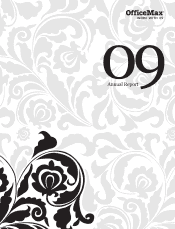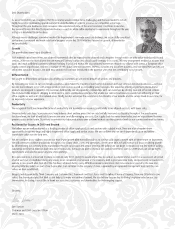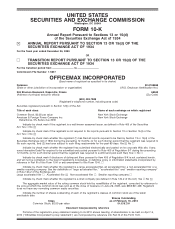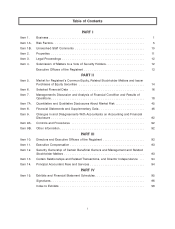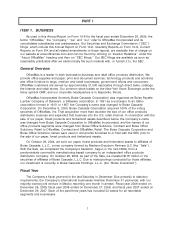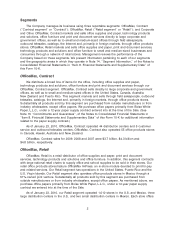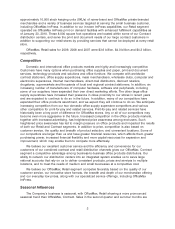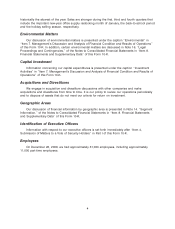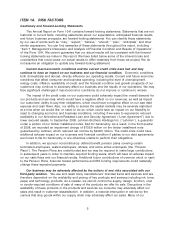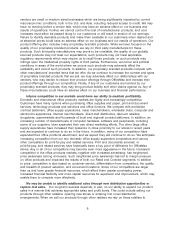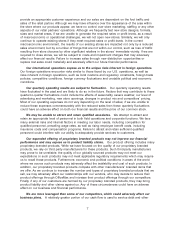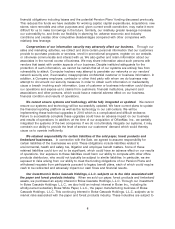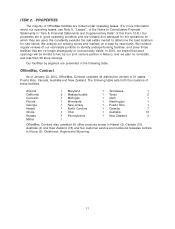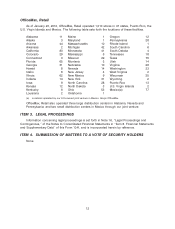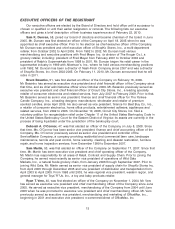OfficeMax 2009 Annual Report Download - page 9
Download and view the complete annual report
Please find page 9 of the 2009 OfficeMax annual report below. You can navigate through the pages in the report by either clicking on the pages listed below, or by using the keyword search tool below to find specific information within the annual report.ITEM 1A. RISK FACTORS
Cautionary and Forward-Looking Statements
This Annual Report on Form 10-K contains forward-looking statements. Statements that are not
historical or current facts, including statements about our expectations, anticipated financial results
and future business prospects, are forward-looking statements. You can identify these statements
by our use of words such as ‘‘may,’’ ‘‘expect,’’ ‘‘believe,’’ ‘‘should,’’ ‘‘plan,’’ ‘‘anticipate’’ and other
similar expressions. You can find examples of these statements throughout this report, including
‘‘Item 7. Management’s Discussion and Analysis of Financial Condition and Results of Operations’’
of this Form 10-K. We cannot guarantee that our actual results will be consistent with the forward-
looking statements we make in this report. We have listed below some of the inherent risks and
uncertainties that could cause our actual results to differ materially from those we project. We do
not assume an obligation to update any forward-looking statement.
Current macroeconomic conditions and the current credit crisis have had and may
continue to have an impact on our business and our financial condition. Economic conditions,
both domestically and abroad, directly influence our operating results. Current and future economic
conditions that affect consumer and business spending, including the level of unemployment,
energy costs, inflation, availability of credit, and the financial condition and growth prospects of our
customers may continue to adversely affect our business and the results of our operations. We may
face significant challenges if macroeconomic conditions do not improve or continue to worsen.
The impact of the credit crisis on our customers could adversely impact the overall demand for
our products and services, which would have a negative effect on our revenues, as well as impact
our customers’ ability to pay their obligations, which could have a negative effect on our bad debt
expense and cash flows. Also, our ability to access the capital markets may be severely restricted
at a time when we would like, or need, to do so, which could have an impact on our flexibility to
react to changing economic and business conditions, including if we were to experience reduced
availability in our Amended and Restated Loan and Security Agreement (‘‘Loan Agreement’’) due to
lower secured assets. In September 2008, Lehman Brothers Holdings Inc. (‘‘Lehman’’), a guarantor
under a portion of our timber installment notes, filed for bankruptcy. As a result, in the third quarter
of 2008, we recorded an impairment charge of $735.8 million on the timber installment note
guaranteed by Lehman, which reduced net income by $449.5 million. The credit crisis could have
additional adverse impact on our business and financial condition if parties to our debt agreements
are forced to file for bankruptcy or are otherwise unable to perform their obligations.
In addition, we sponsor noncontributory defined benefit pension plans covering certain
terminated employees, vested employees, retirees, and some active employees (the ‘‘Pension
Plans’’). The Pension Plans are under-funded and we may be required to make large contributions
in subsequent years in order to maintain required funding levels, which will have an adverse impact
on our cash flows and our financial results. Additional future contributions of common stock or cash
to the Pension Plans, financial market performance and IRS funding requirements could materially
change these expected payments.
Our business may be adversely affected by the actions of and risks associated with our
third-party vendors. We use and resell many manufacturers’ branded items and services and are
therefore dependent on the availability and pricing of key products and services including ink, toner,
paper and technology products. As a reseller, we cannot control the supply, design, function, cost
or vendor-required conditions of sale of many of the products we offer for sale. Disruptions in the
availability of these products or the products and services we consume may adversely affect our
sales and result in customer dissatisfaction. In addition, a material interruption in service by the
carriers that ship goods within our supply chain may adversely affect our sales. Many of our
5

